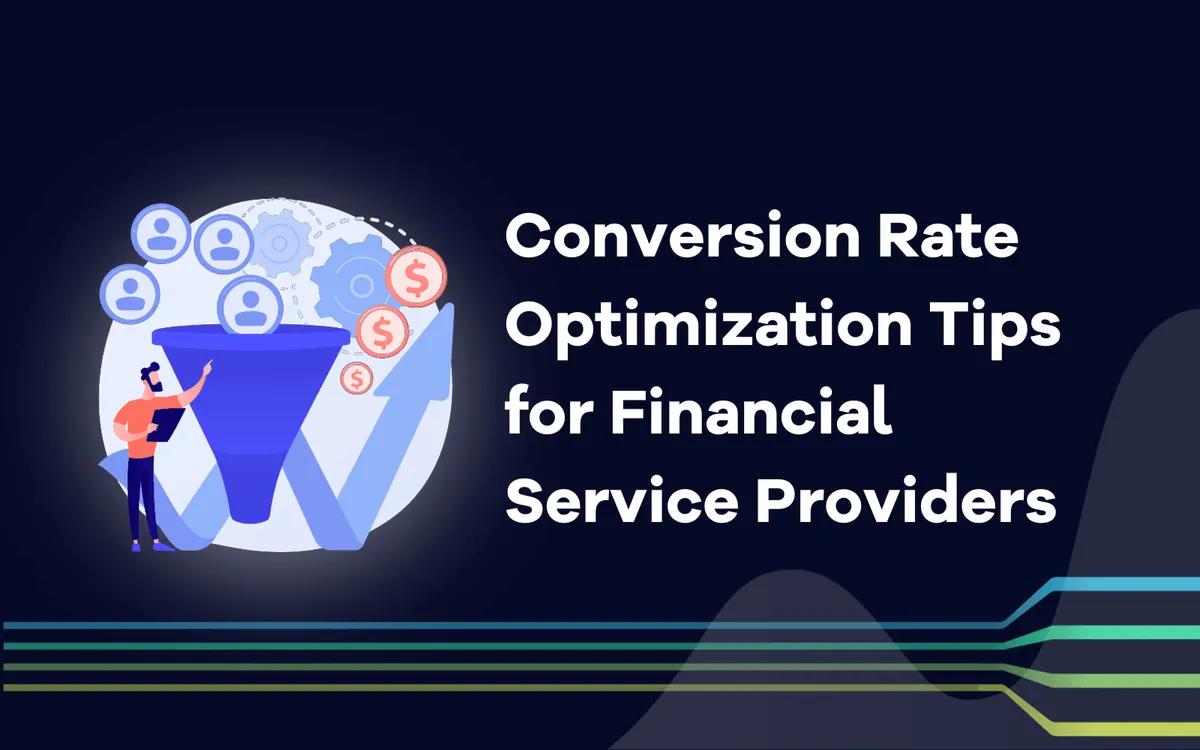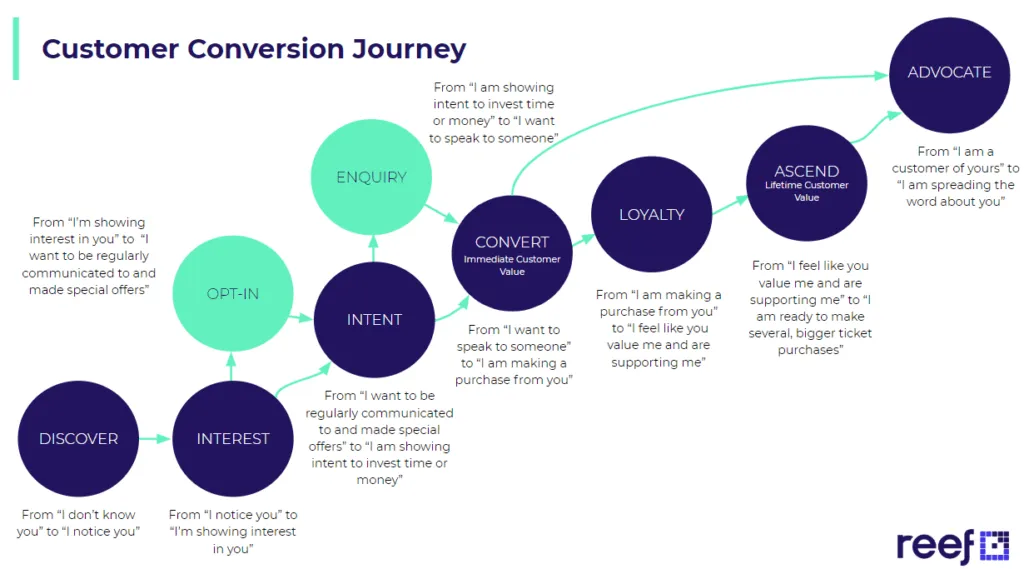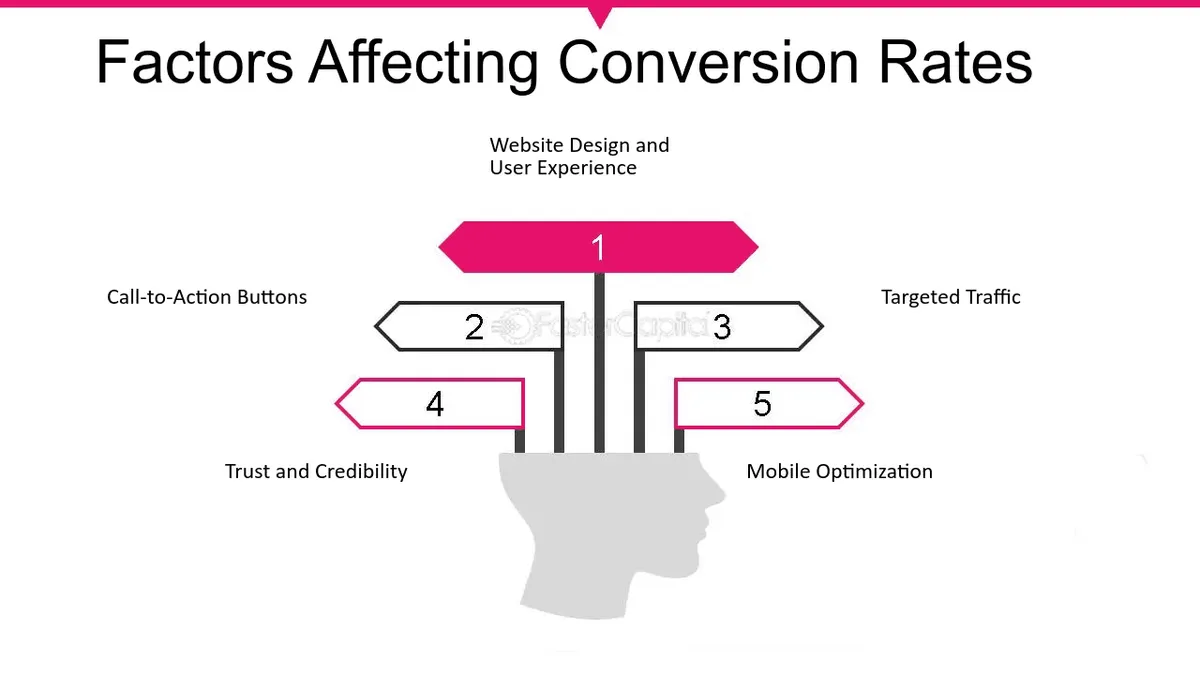
Conversion Rate Optimization Tips for Financial Service Providers

Carl Fisher
November 13, 2023
Unlock success in the competitive financial landscape with these expert Conversion Rate Optimization (CRO) tips tailored for financial service providers.

In the bustling digital marketplace, your website isn't just a billboard—it's a living, breathing virtual branch of your business. But what separates the thriving financial hubs from the digital ghost towns? It's all about mastering the art of Conversion Rate Optimization (CRO). CRO is the science (and a bit of art) of not just attracting visitors, but turning them into loyal customers who trust you with their hard-earned cash.
But here's the kicker—CRO for financial services isn't like selling t-shirts or gadgets. It's a whole different ballgame with higher stakes, stricter rules, and a need for bulletproof trust. In the next 1700 words, you'll get the lowdown on everything from A/B testing to privacy laws, all tailored to the unique world of financial services. Whether you're looking to finesse your forms or streamline your services, I've got practical, actionable tips backed by data that will take your website from a mere digital presence to a conversion powerhouse. So, buckle up, and let's turn those browsers into buyers and those clicks into clients!

Source: Search Engine Journal
What does conversion mean for financial services?
In financial services, "conversion" doesn't just mean a casual online purchase—it's the critical point where a prospect crosses the threshold and becomes a client, entrusting you with their financial well-being. Unlike e-commerce, where a conversion might be adding to a cart and checking out, here it's about convincing customers to sign up for a service, schedule a consultation, download a white paper, or even invest in a long-term financial product. These actions are far more complex and require a deep level of trust and assurance.
Each conversion signifies a significant commitment, often involving sensitive information and large sums of money. It's a journey from curiosity to confidence, and every touchpoint is an opportunity to build a relationship that could span decades. So, let’s unpack how to optimize each step to ensure that when prospects hit 'submit', they're starting a new financial chapter with you.
The big deal about CRO in financial services
CRO in financial services is more than just tweaking a landing page—it's about forging a path of least resistance for your clients to commit to high-stakes decisions. It’s crucial because even the slightest friction can cost you a potential lifelong customer and significant AUM (Assets Under Management). In this industry, a conversion could mean the difference between a client investing thousands with your firm or clicking away to a competitor.
The high trust barrier inherent in financial decisions means that every element of your site must reinforce credibility and clarity. From the clarity of your value proposition to the security of the transaction process, every detail counts double in finance. Moreover, given the competitive nature of the sector, CRO isn't just a nice-to-have; it's a critical battleground where winning client trust is as valuable as the services you offer. The right CRO strategies can transform your website into a dynamic tool that draws clients in and guides them seamlessly through the decision-making process.
8 tips for conversion rate optimization
We’re done explaining CRO's utmost importance for financial services providers. Let’s move on to some actionable tips, which is why you’re here.
#1 Analyze your current conversion pathways
First, we need to dive into the nitty-gritty of analyzing your current conversion pathways. This is detective work at its finest—tracing the digital footprints of your visitors to see where they linger, hesitate, and ultimately, take the plunge to convert—or slip through your fingers. Think of your website as a complex network of roads and your potential clients as travelers. You want to make their journey from Point A, "just browsing," to Point B, "let's do business," as smooth and straightforward as possible.
To nail this, you need to understand each customer journey phase. Which pages are they landing on first? What's drawing their attention? And crucially, where are the roadblocks? Are they getting lost on the way to the 'Contact Us' page, or are they abandoning the ship when they hit the 'Sign Up' form? By leveraging analytics, you can spot trends, see where visitors are dropping off, and identify pages that aren't performing up to par.
But don't just stop at the what; figure out the why. Is it unclear information? Intimidating forms? A lack of trust signals? Remember, in financial services, the stakes are high. A client won't click 'submit' on an investment portfolio or insurance plan if they hit a single bump in the road. So, it's essential to analyze, refine, and test continuously. Your goal? A conversion pathway so smooth, it feels like cruising on the autobahn.

Source: Reef Digital
#2 User Experience and Design for Conversion
When we talk about user experience (UX) and design in the context of conversion rate optimization (CRO), we're focusing on the user's journey through your financial service website. The design isn't just about aesthetics; it's about creating an intuitive, user-friendly environment that guides visitors toward the goal - whether it's signing up for a newsletter, creating an account, or starting an investment.
Here's the thing: in financial services, trust is the currency. Your website must embody this trust through professional web design, straightforward navigation, and clear, accessible information.
Prioritize clarity and simplicity. Your website should clearly communicate its purpose and guide users effortlessly toward conversion goals. Simplify navigation and minimize clutter so the user's path to conversion is evident and direct.
Establish trust with professional design. Use a clean, professional design to reinforce the credibility of your financial services. A well-designed website can enhance user trust, which is essential for conversion in the finance sector.
Optimize calls-to-action (CTAs). Your CTAs should stand out and encourage action without being too aggressive. Use persuasive language that resonates with your audience and place CTAs strategically to align with the user's information-gathering process. For instance, you can use the latest landing page statistics as your guide when designing landing pages.
Streamline forms. When designing forms, ask only for essential information to reduce friction. Use reassuring language and explain why certain information is needed, easing concerns over privacy and security.
Consistency in design. Keep your branding and messaging consistent across all pages. Consistency keeps users oriented and reinforces brand identity, aiding in the recognition that can boost conversions.
Mobile-first approach. Design with a mobile-first mindset, ensuring that all design elements work seamlessly on smaller screens, which is crucial as more users access financial services via mobile devices.
A/B testing. Regularly test different design elements to see what works best for your audience. A/B testing can reveal valuable insights into user preferences and behaviors, leading to improved conversion rates.
Feedback loops. Incorporate mechanisms for user feedback on your website. User insights can direct your UX improvements and indicate where the design may be falling short.
Accessibility matters. Ensure that your website is accessible to all users, including those with disabilities. Accessibility can significantly widen your audience and is a legal requirement in many jurisdictions.
#3 Optimizing on-page elements for higher conversions
Optimizing on-page elements is a vital part of conversion rate optimization for financial service providers. It's all about making the necessary tweaks and enhancements to your website to nudge visitors toward becoming clients or customers. Here's a breakdown of what you can do to give your on-page elements a conversion-focused overhaul.
Craft compelling headlines. Your headlines should grab attention and clearly state the benefits of your service.
Improve CTA visibility. Place your CTAs in prominent positions and use colors that stand out, yet remain harmonious with your site’s color scheme.
Use persuasive copy. Write copy that speaks directly to the user’s needs and concerns, using language that incites action.
Optimize forms. Reduce form fields, use engaging microcopy, and provide clear instructions to decrease abandonment rates.
Leverage social proof. Include testimonials, online reviews, and trust badges to reassure visitors of your credibility and the quality of your services.
Use high-quality visuals. Incorporate professional images and videos that reflect your services’ value and aid in storytelling.
Test and adapt. Utilize A/B testing to find the most effective version of each on-page element, from buttons to images to text.
Responsive design. Ensure all on-page elements are optimized for a seamless experience across all devices.
#4 Enhancing trust factors
 Source: Faster Capital
Source: Faster CapitalBuilding trust is a cornerstone in converting users into clients, particularly for financial services where the stakes are high. To establish this trust through your website, start with highlighting your credentials. Prominently feature any certifications, accolades, and affiliations, as they underscore your credibility within the financial sector.
Transparency is key—ensure your service descriptions, fees, and pricing are clear and easy to understand. This simplicity helps demystify financial services, making them more accessible to prospective clients. You can use feature request tools to listen to your users’ feature feedback to understand what your customers want and make informed product decisions.
The inclusion of customer testimonials and success stories adds a layer of social proof, offering relatable endorsements of your services. These real-life experiences can significantly sway decision-making in your favor.
Prioritize security by implementing SSL certificates and explicit privacy policies to protect user data, reassuring visitors of their safety on your platform.
Ensure that your contact information is prominent, providing an open invitation for inquiries and signaling readiness to assist, which reinforces your reliability.
Lastly, offer valuable educational content that not only displays your expertise but also serves as a useful resource to your clients, positioning your firm as a knowledgeable advisor in their financial endeavors. The content should also be SEO optimized and written with the right keywords. You can rely on Accuranker to build your organic visibility.
#5 Streamlining the conversion process
Streamlining the conversion process on a financial services website is about making the journey from prospect to customer as smooth and straightforward as possible.
Consider the user journey. Every step a potential client takes should be intuitive, leading them naturally towards the goal, whether it’s signing up for a newsletter or scheduling a consultation. If a user encounters a roadblock or confusion, the chance of conversion drops precipitously. Therefore, regular audits of the user pathway, ideally through user testing, can identify and rectify any snags.
Additionally, integrating an efficient CRM system aids in a seamless transition. When a user fills out a form, immediate acknowledgment via an automated email can keep engagement high and provide reassurance that their request is being processed. Following up swiftly with a personalized response ensures the user feels valued and maintains momentum towards conversion.
For mobile users, the importance of a responsive design cannot be overstressed. The process must be just as easy on a smartphone as it is on a desktop, with all elements loading quickly and fitting neatly on the screen to avoid user frustration.
#6 Mobile optimization strategies

Source: Search Engine Journal
The days when mobile optimization was considered a trend are long gone; for financial service providers, it's a must-do to engage the growing number of users who prefer managing their finances on-the-go. With mobile devices now driving a significant portion of online traffic, your website's mobile experience can make or break the conversion journey.
Start by embracing responsive design. This ensures your website adjusts seamlessly to any screen size, providing an optimal viewing experience across all devices. A responsive design eliminates the need for pinching, zooming, and scrolling that can frustrate users and lead to abandonment.
The page load speed on mobile is also critical. With users' attention spans getting shorter, every second counts. Optimize images, leverage browser caching, and minify code to ensure lightning-fast page loads. Remember, a delay of even a few seconds can cause a significant drop in conversions.
Touchscreen navigation must be intuitive and effortless. Buttons, links, and call-to-action (CTA) elements need to be of a suitable size for tapping with a finger, with ample space to prevent errors. Simplify menus and limit the amount of text entry required by utilizing toggles, sliders, or dropdowns.
Lastly, consider the mobile content itself. Conciseness is key. Long paragraphs can be daunting on smaller screens. Break text up with bullet points or short, punchy paragraphs, and use compelling headlines to guide users through the content to the conversion point.
#7 Harnessing Social Media for Enhanced CRO
A robust social media presence is indispensable for amplifying CRO. It's where your financial brand gains a voice and an audience, fostering trust through engagement and personalized content.
By integrating CRO strategies with social media, financial service providers can direct a stream of highly engaged traffic towards optimized conversion funnels. Use targeted social media campaigns to showcase success stories and client testimonials, which act as social proof to bolster credibility.
Engage with interactive content like polls and Q&As to understand your audience's needs, and then drive these informed prospects to landing pages designed with conversion in mind. Test different ad formats and messaging to see what resonates, and use the rich data available through social platforms to refine your approach continually.
When you embed Instagram feed directly into your website, you can also supercharge your conversion rate optimization efforts, creating a visually compelling narrative that aligns with your financial services' trustworthiness and expertise. Instagram's dynamic feed can showcase real-time client testimonials, infographics that demystify complex financial concepts, and snapshots of your team in action—each post acting as a stepping stone towards conversion.
#8 Leveraging A/B testing for continuous improvement
Leveraging A/B testing is akin to having a crystal ball, but for your website's conversion rates. This powerful tool allows financial service providers to peek into alternate realities where they can see how small changes impact user behavior. The beauty of A/B testing lies in its simplicity: you compare two versions of a webpage to see which one performs better in terms of driving conversions.
Say you're unsure whether a red 'Apply Now' button will outperform a green one. An A/B test can give you a definitive answer based on real user interactions. It's not just about color psychology, though. You can test variations in your copy, your calls to action placement, different images, or even entire page layouts.
The key is to test one change at a time to pinpoint exactly what influences any conversion rate shifts. And remember, what works for one financial service website may not work for another, so personal insights are invaluable. Your audience is unique, and A/B testing helps you understand them better.
By continually employing A/B testing, you're not just guessing what might resonate with your potential customers but using actual data to make informed decisions. This ongoing refinement process ensures your website stays optimized for conversions, adapting over time to changes in user preferences and behaviors.
Conclusion
In wrapping up our exploration of Conversion Rate Optimization for Financial Service Providers, it's clear that the journey to higher conversion rates is ongoing and dynamic. Remember, conversion rate optimization isn't a one-and-done deal; it's about constantly fine-tuning and adapting to your audience's evolving needs. The strategies we've discussed are your tools for staying competitive in a field where trust, clarity, and user experience are paramount.
Keep testing, keep analyzing, and always strive for that seamless blend of technology and personal touch. Whether it's through enhancing trust factors, streamlining processes, or optimizing for mobile, your goal is to create a journey that feels so natural to the user, they hardly notice they've reached their destination. Keep these tips as your guiding stars, and you'll navigate the vast sea of financial services with a clear course towards conversion success.
Related blog posts

How LLMs Change Traditional SEO Metrics
Learn why rankings, CTRs, and impressions fail to measure visibility in AI-powered search — and what SEOs should track instead.
15 July 2025LLM Tracking Explained
Learn what LLM tracking is and why being mentioned in AI-generated answers is becoming a vital layer of visibility in SEO.
13 July 2025The Hidden Flaws in Search Volumes and How to Solve Them
Learn how AI Search Volume delivers reliable search volumes by combining GKP, GSC, and Trends so that you can prioritize the right keywords.
1 July 2025




